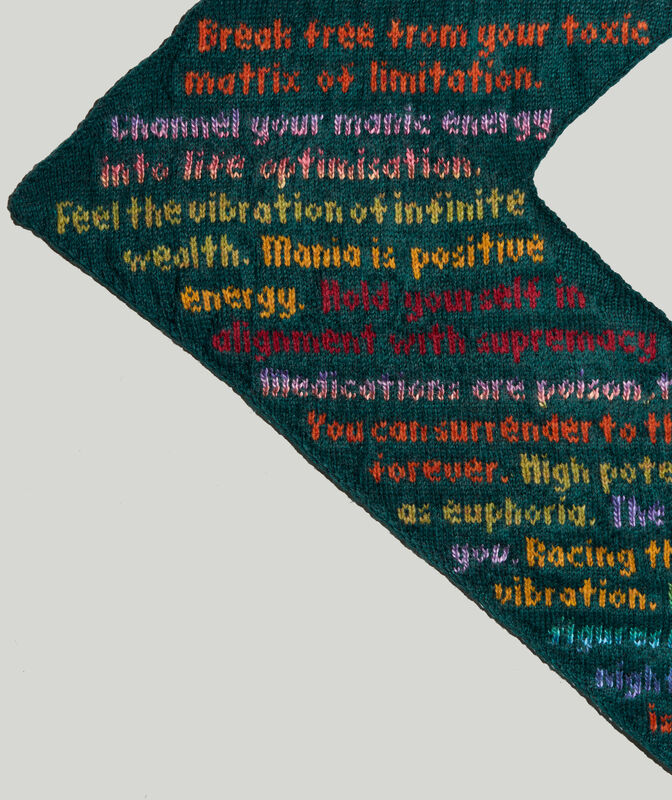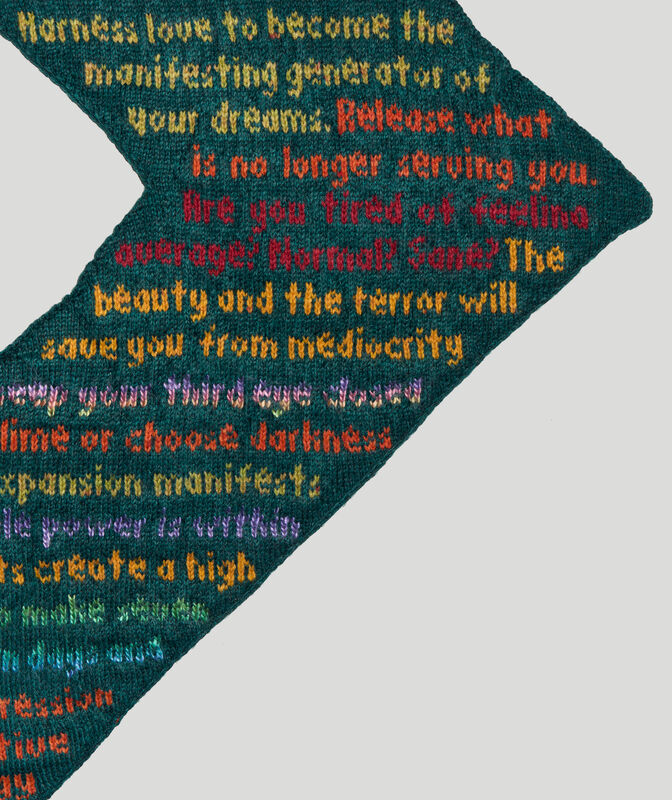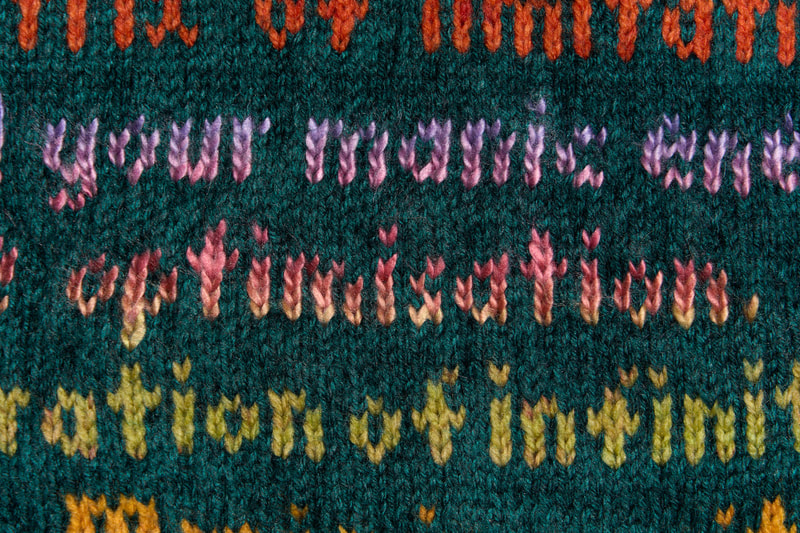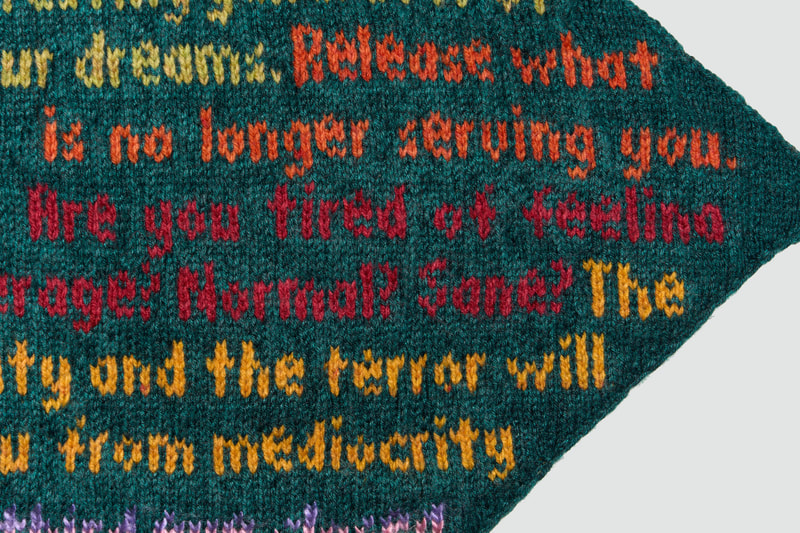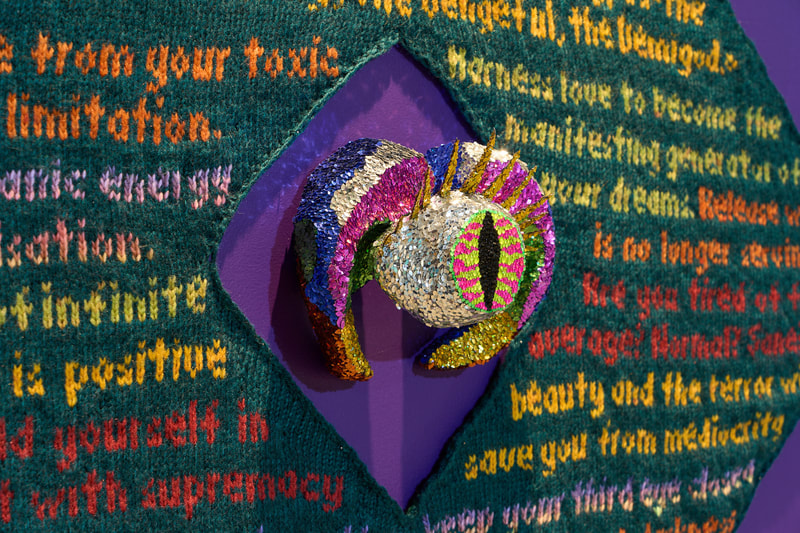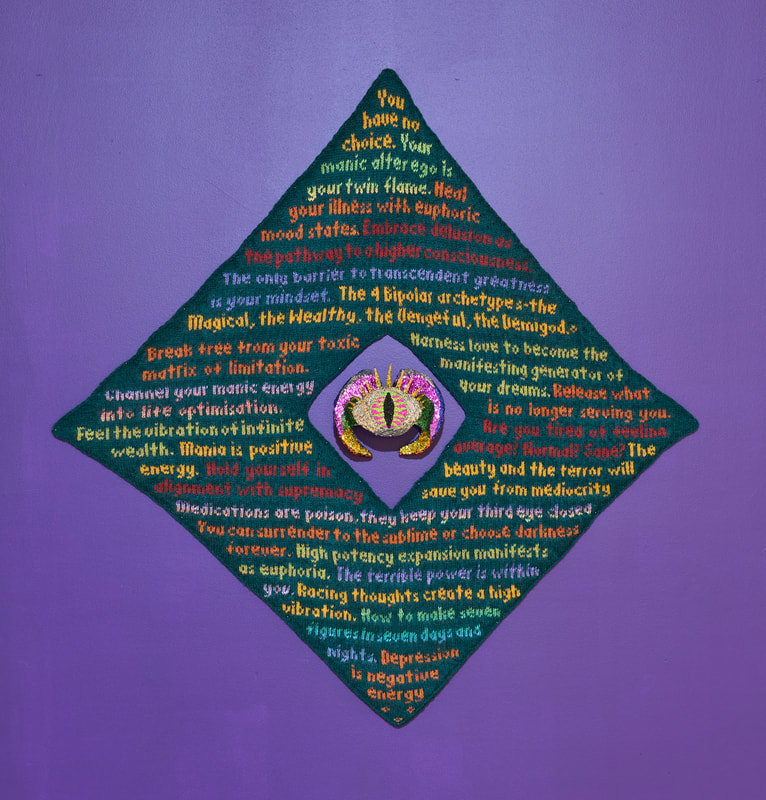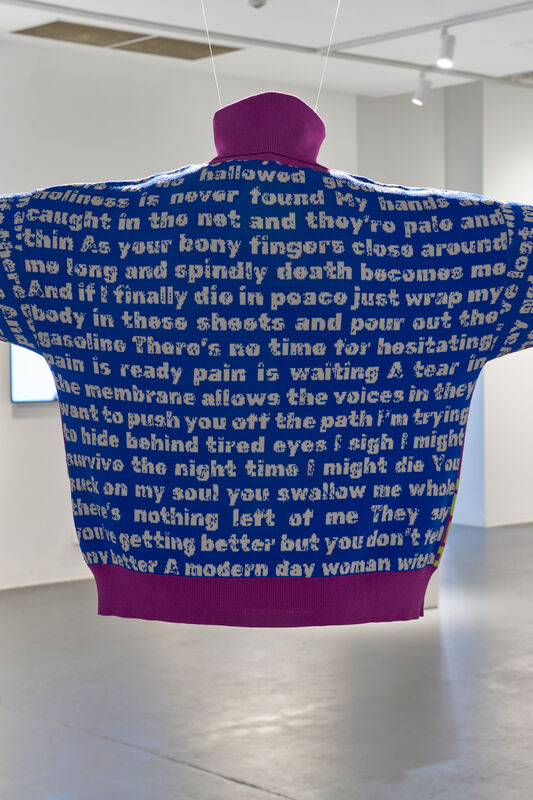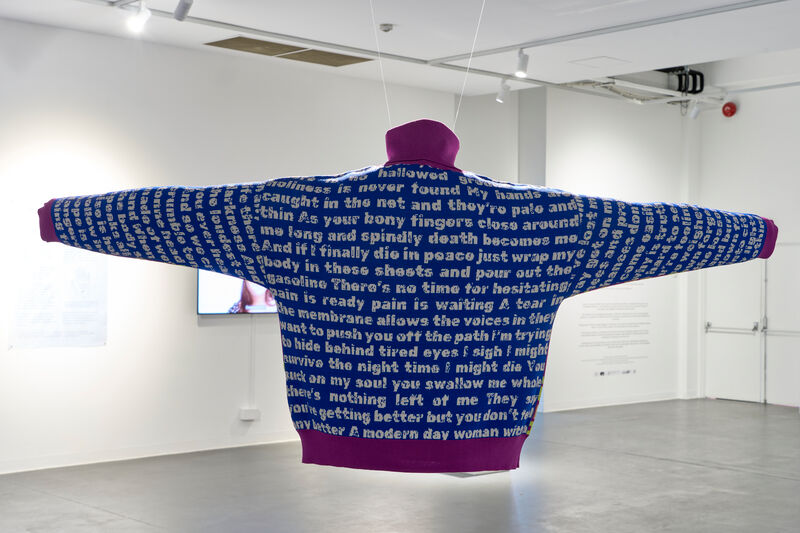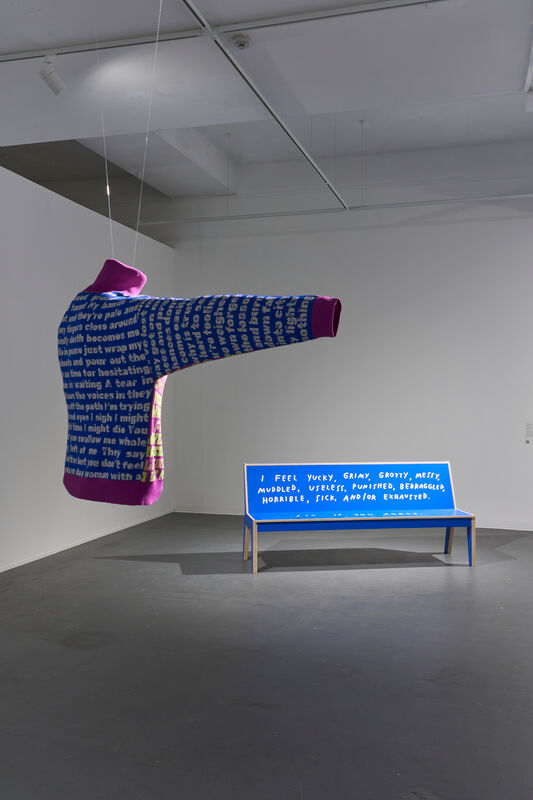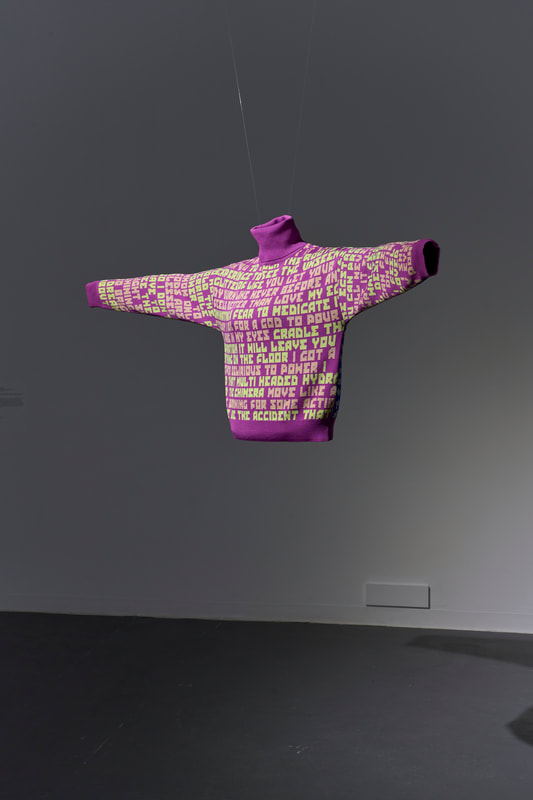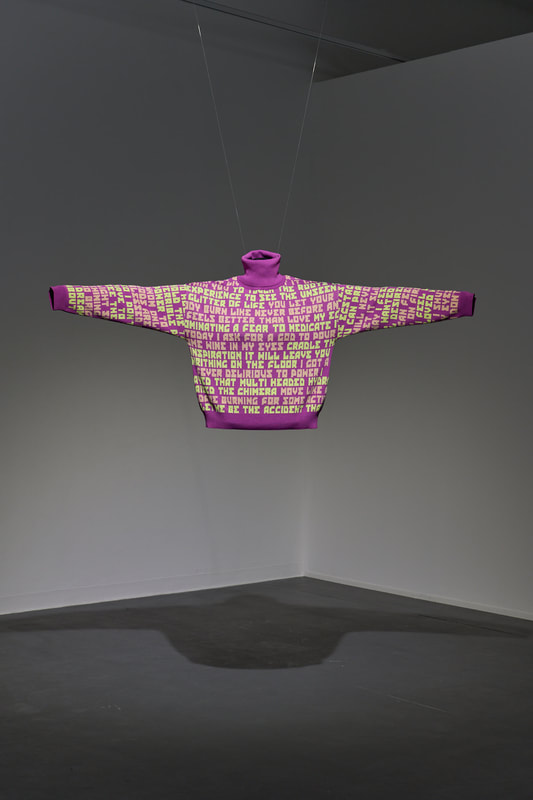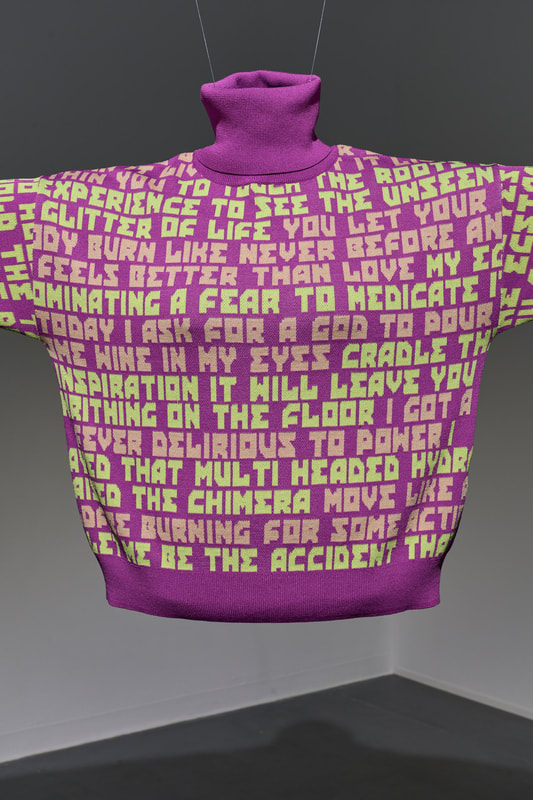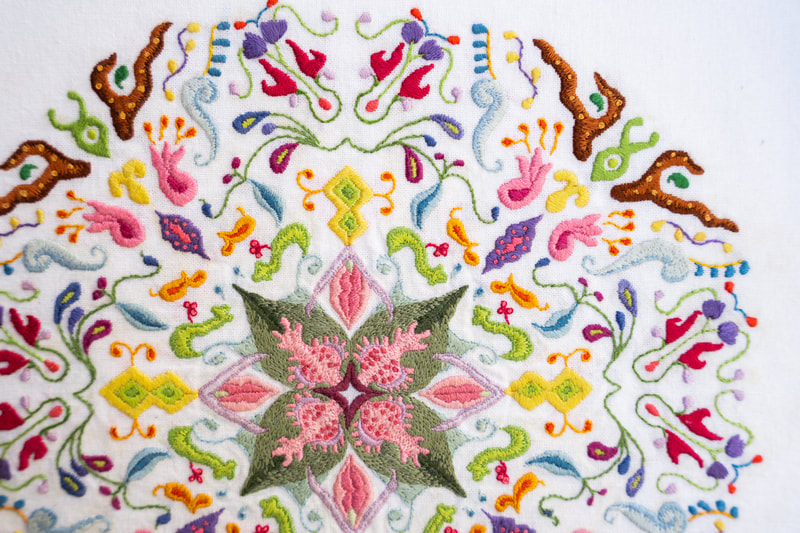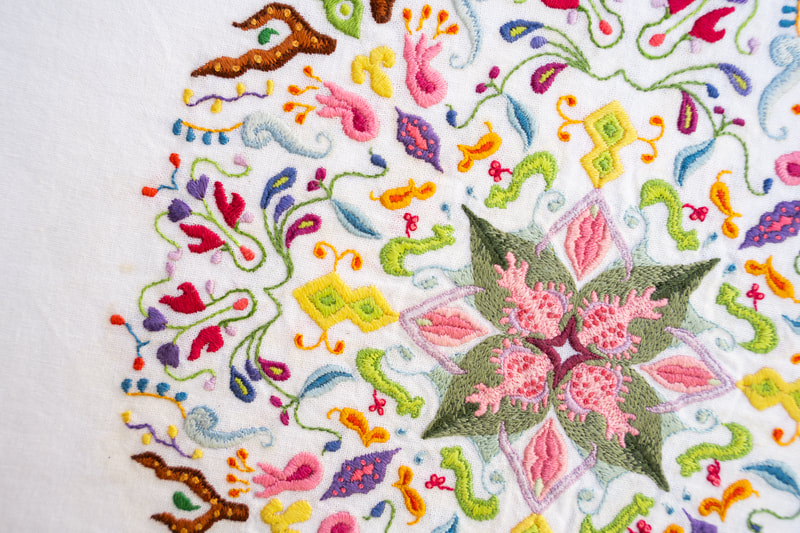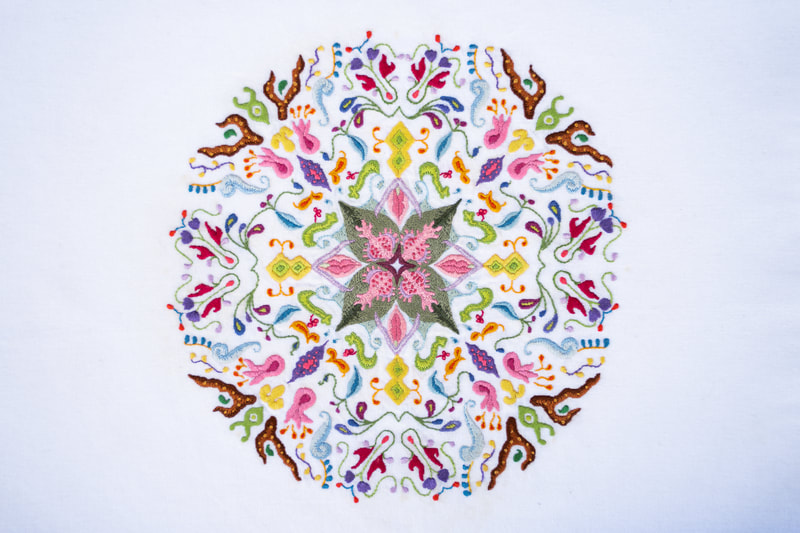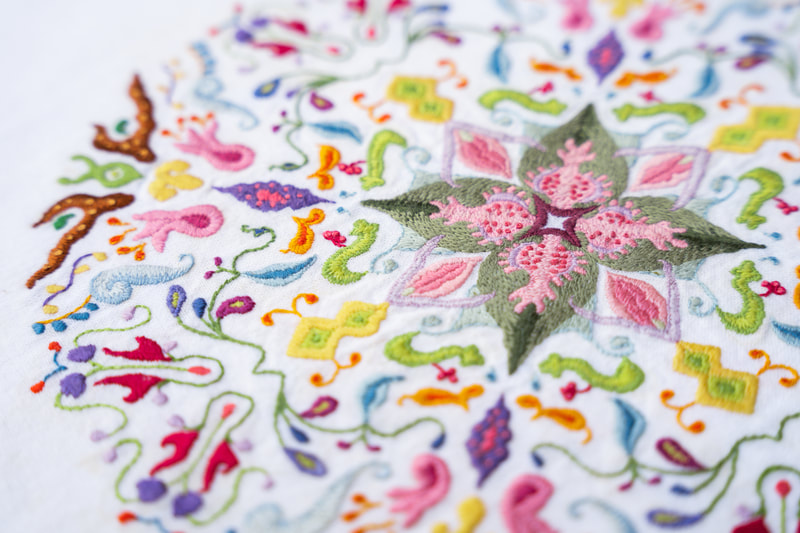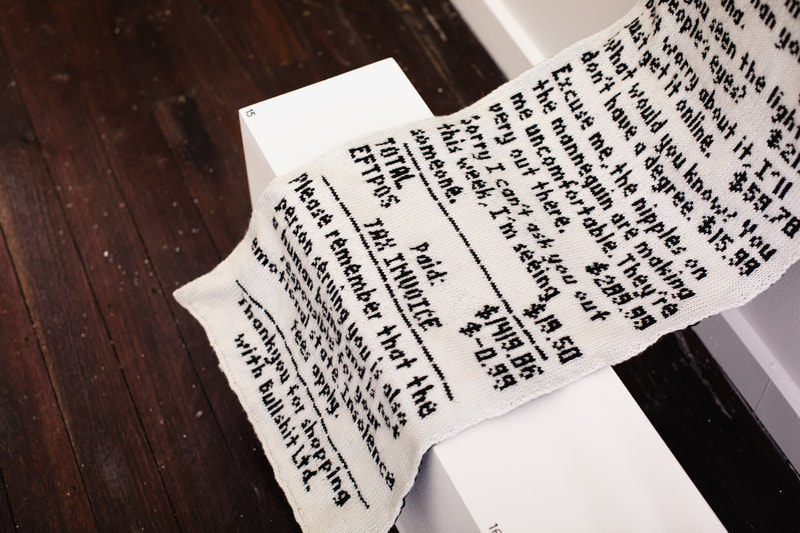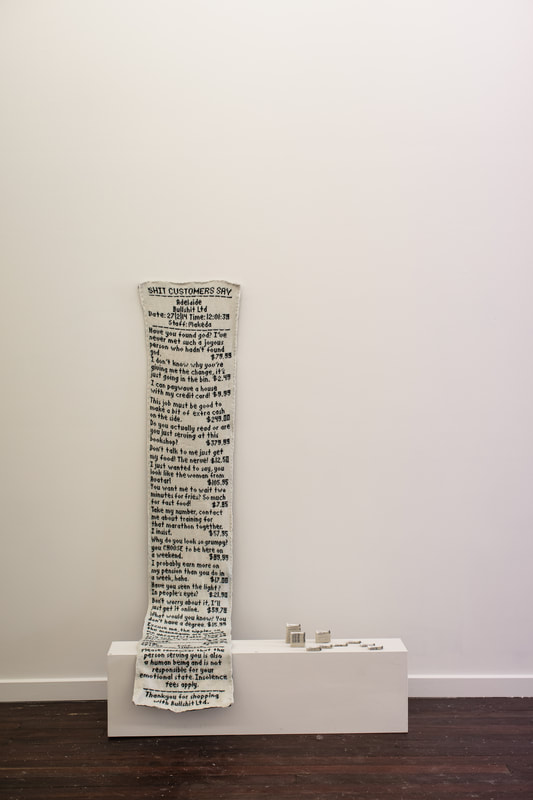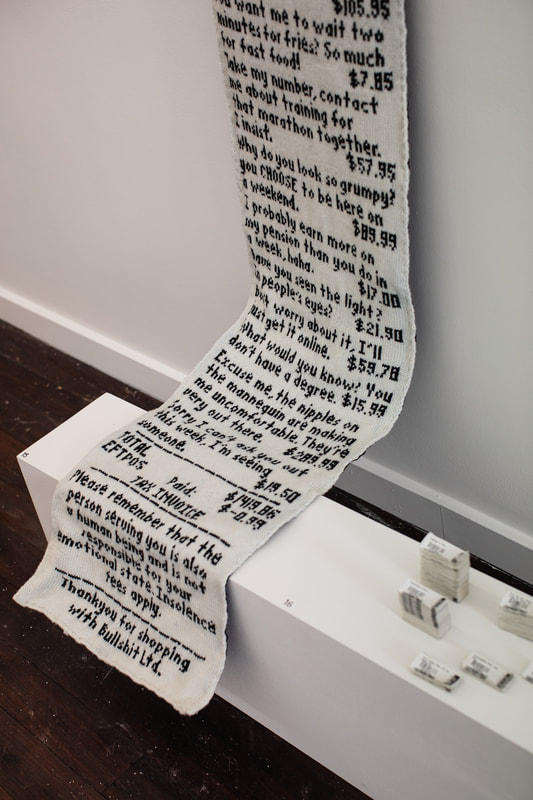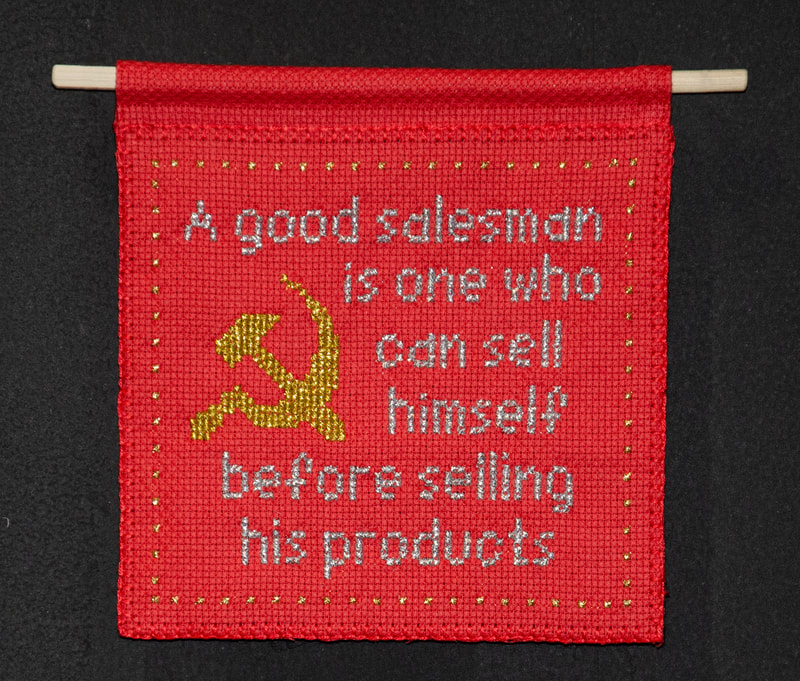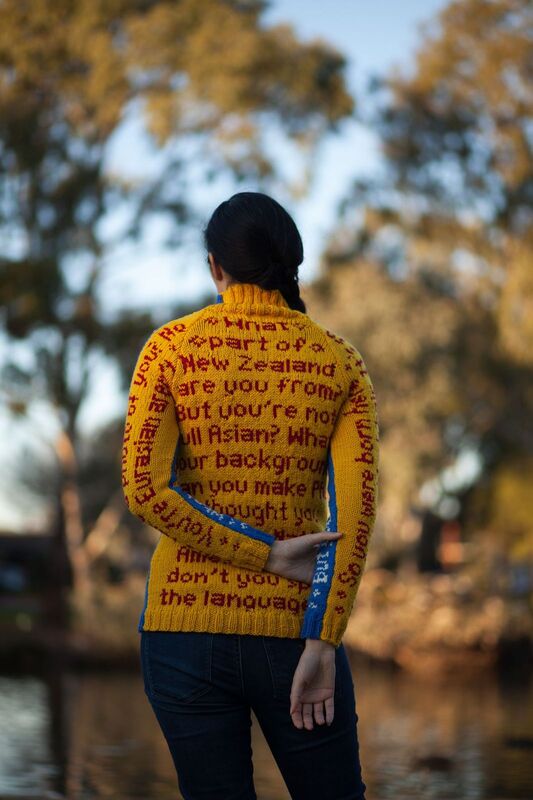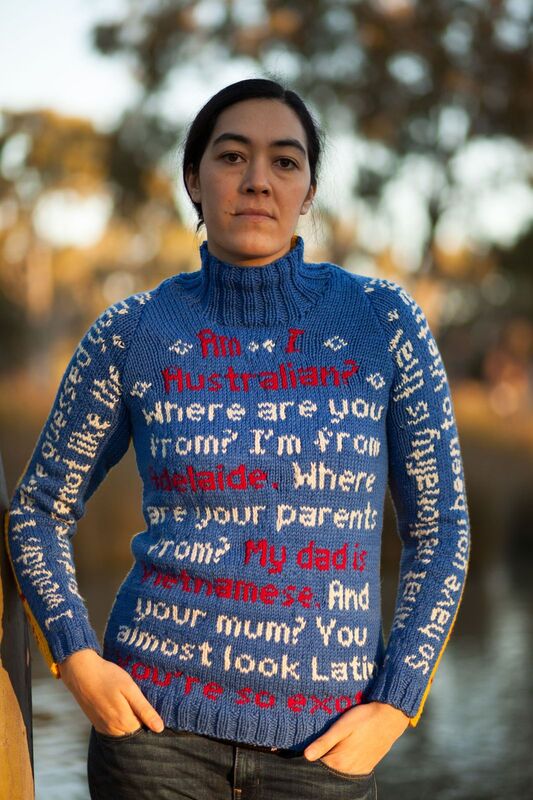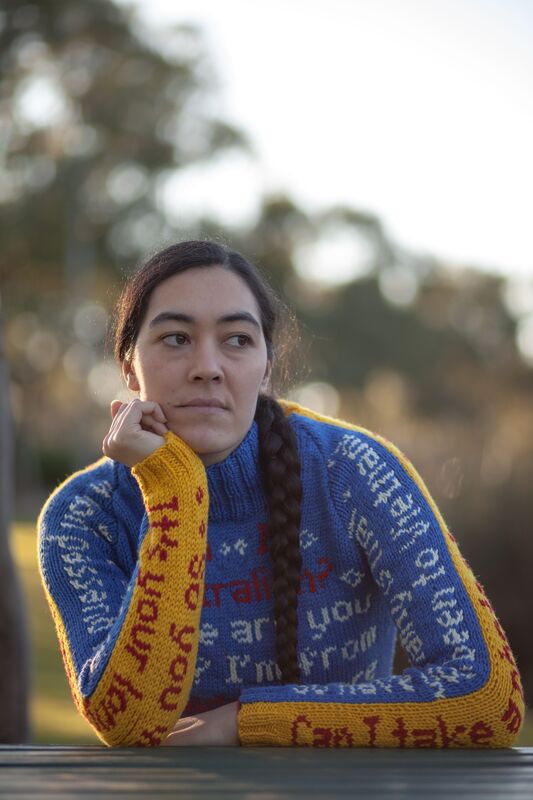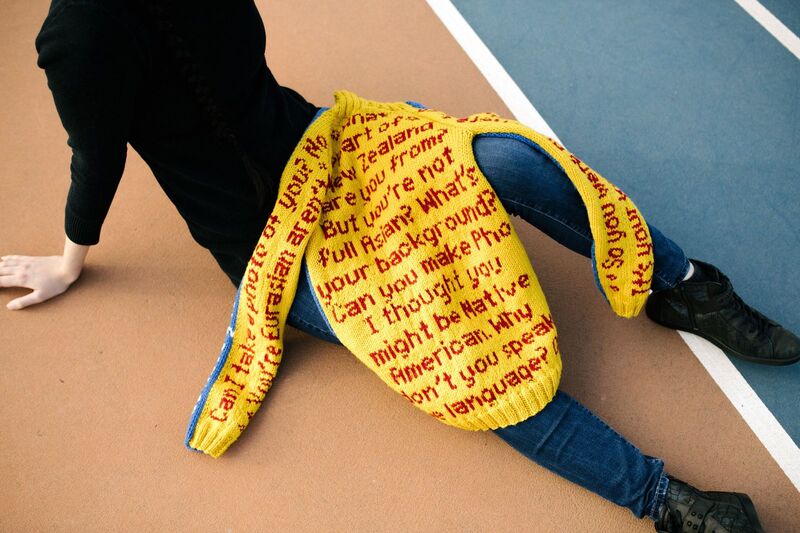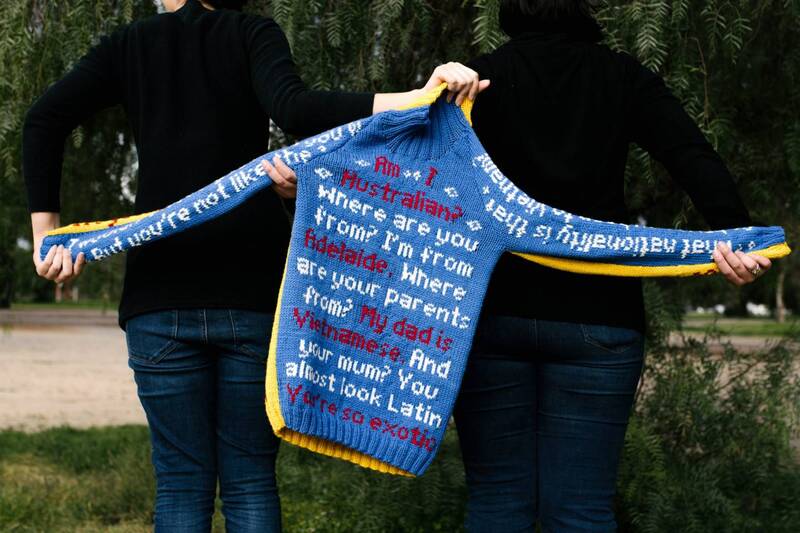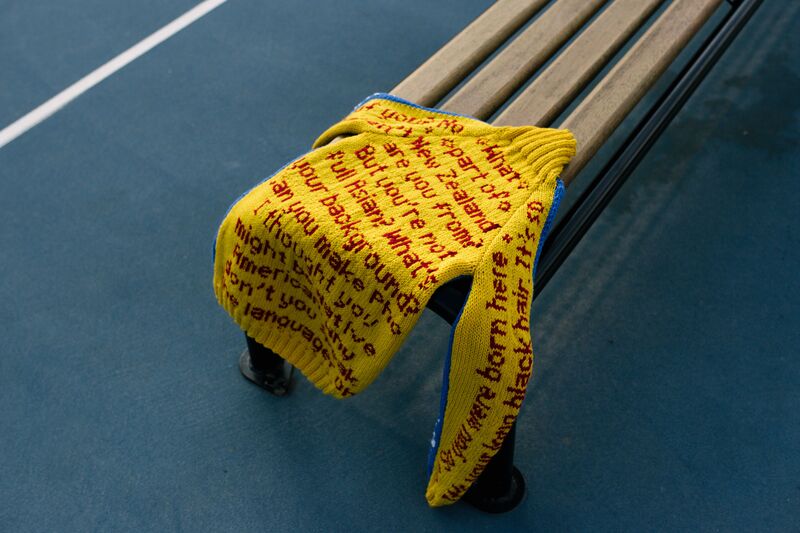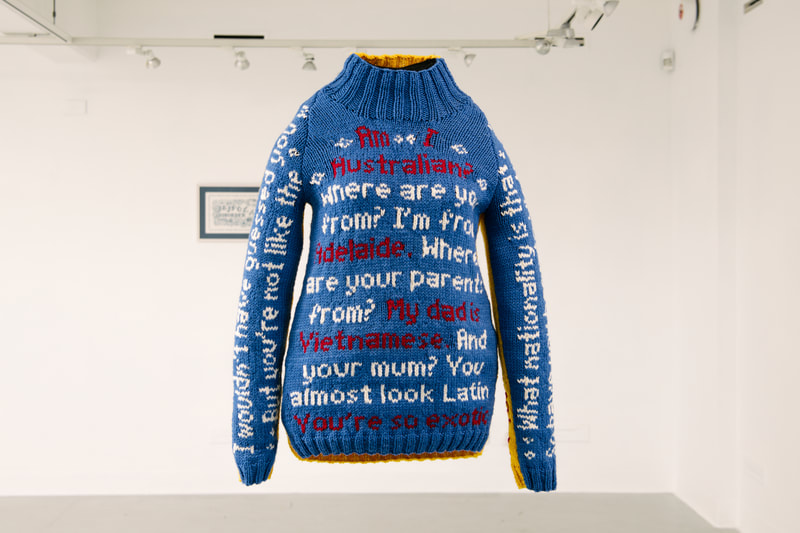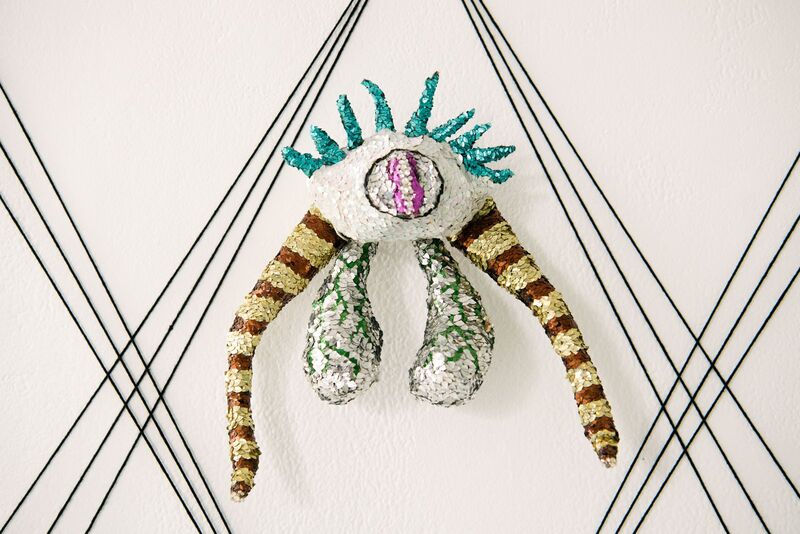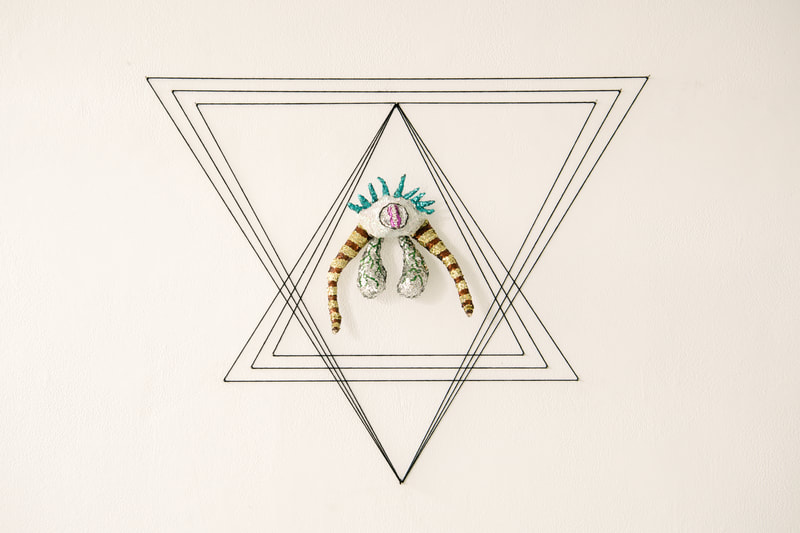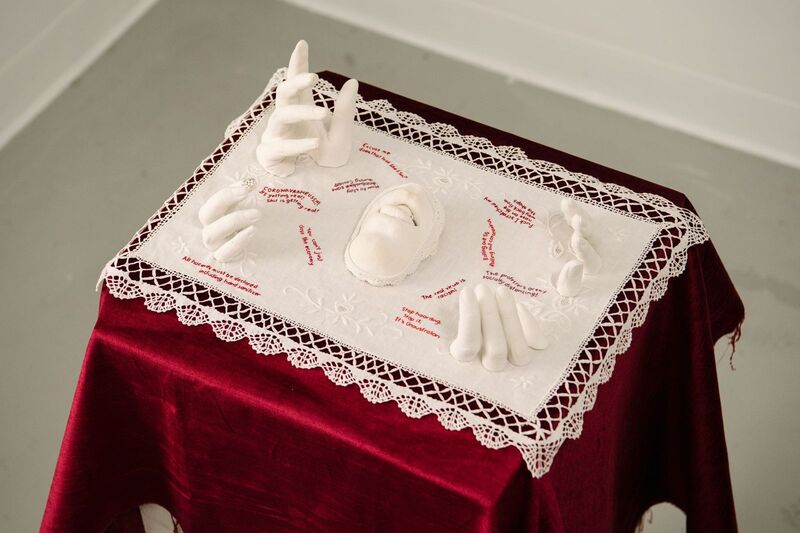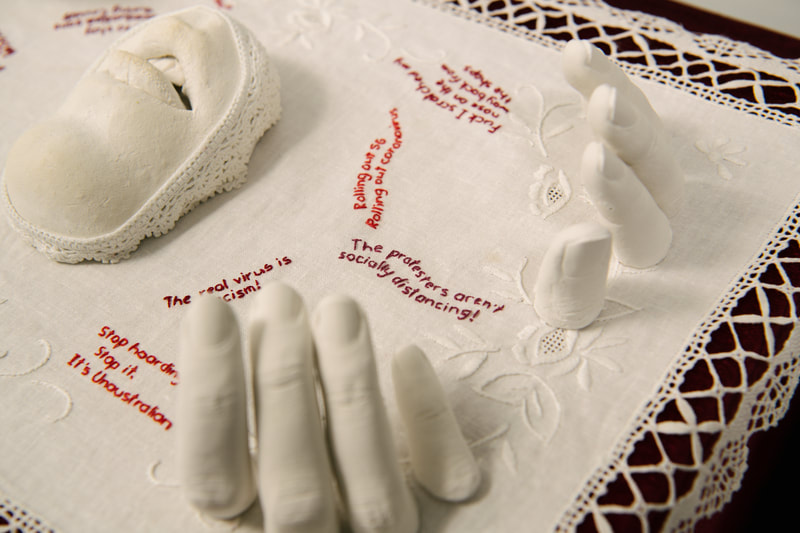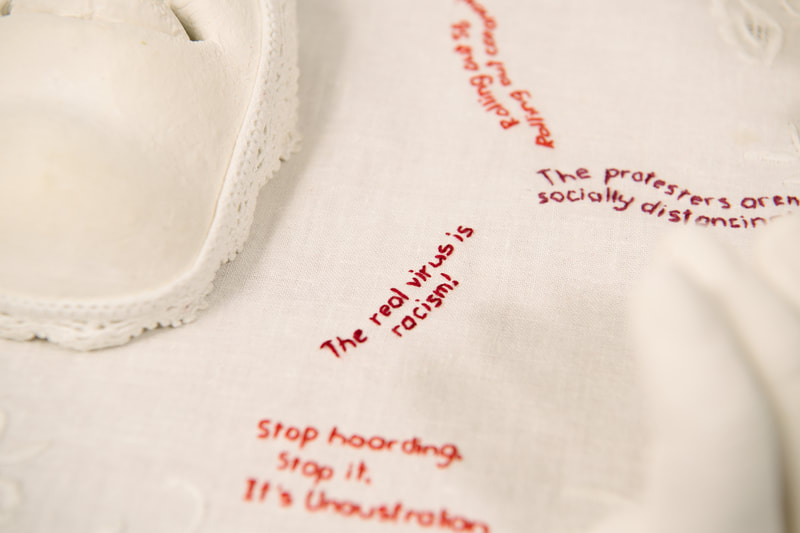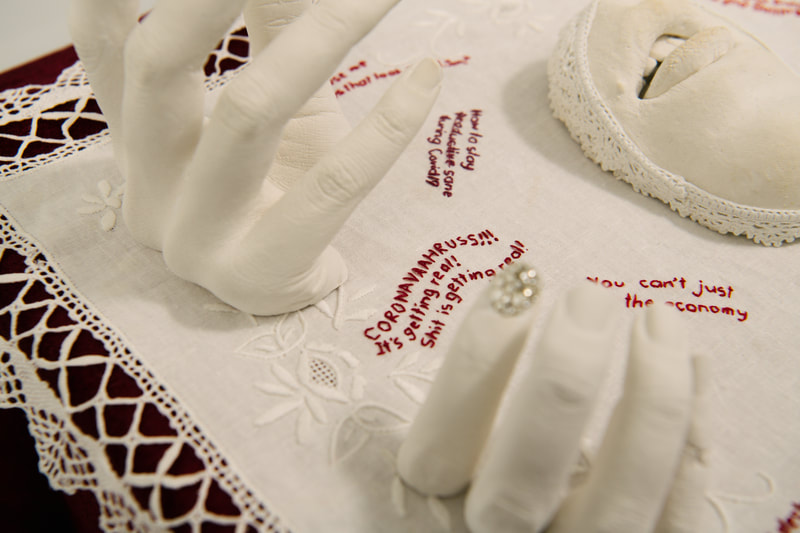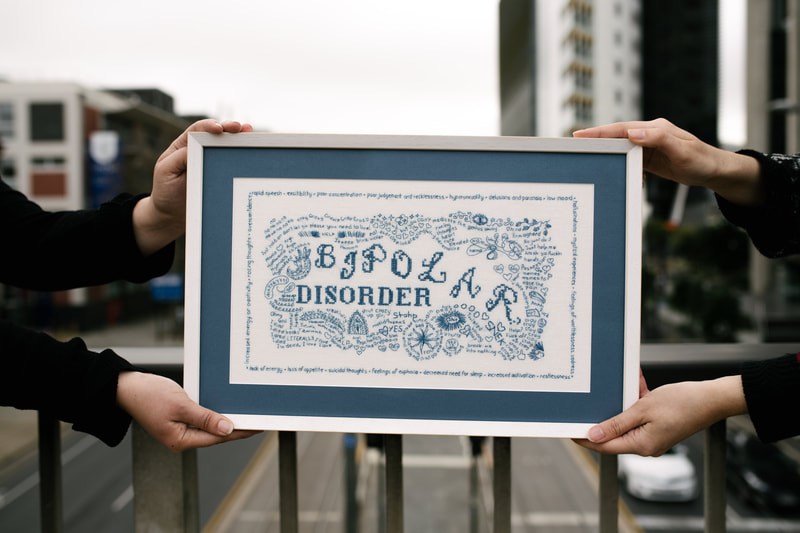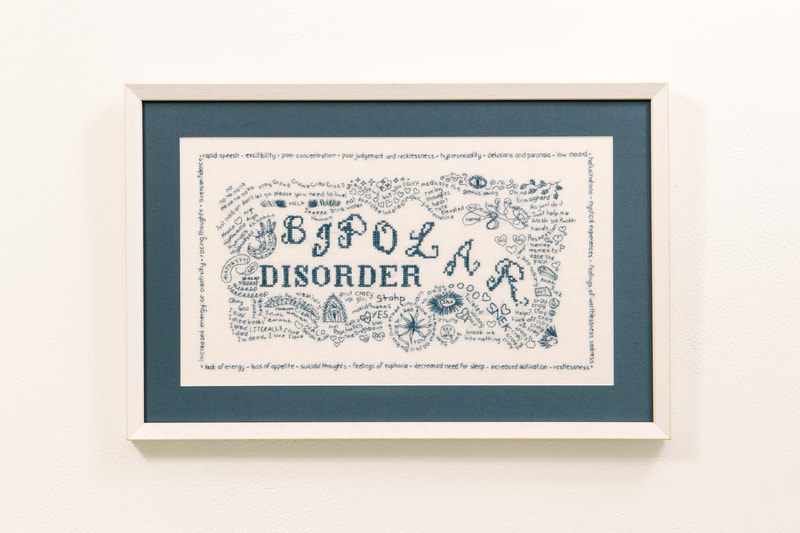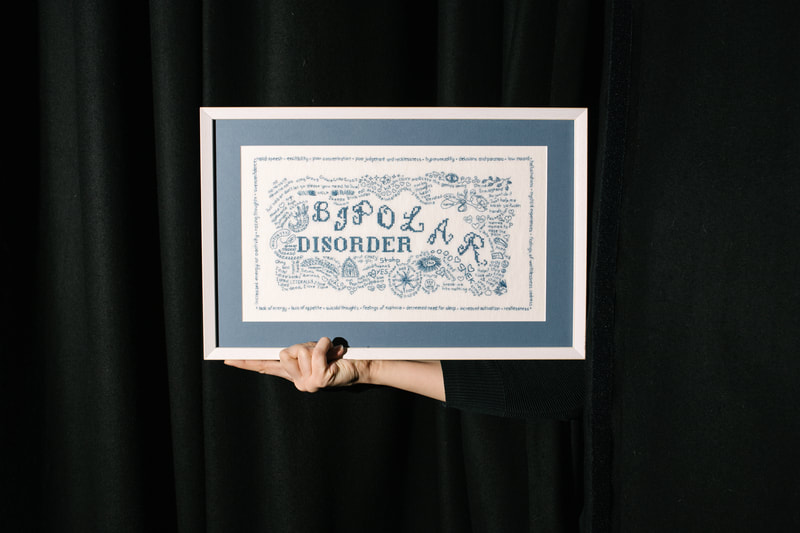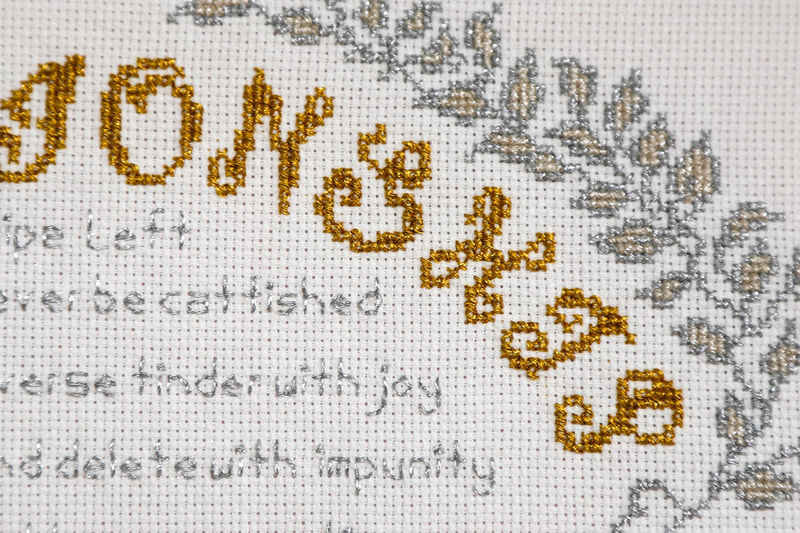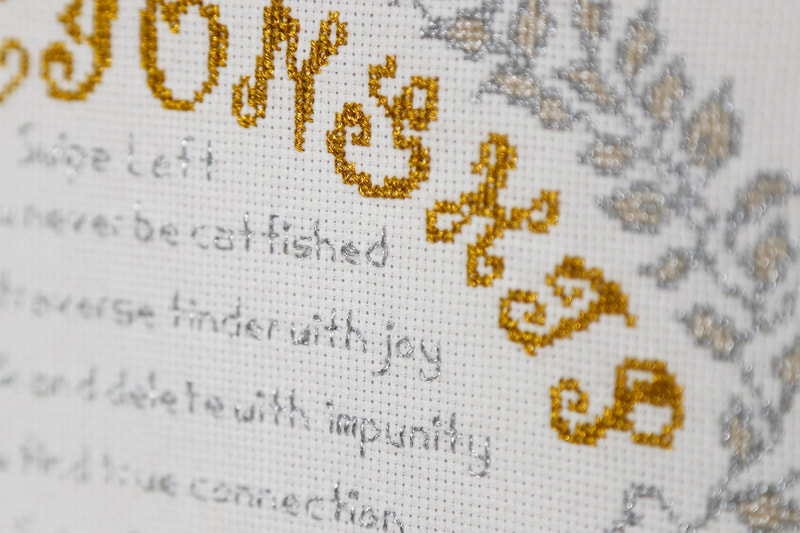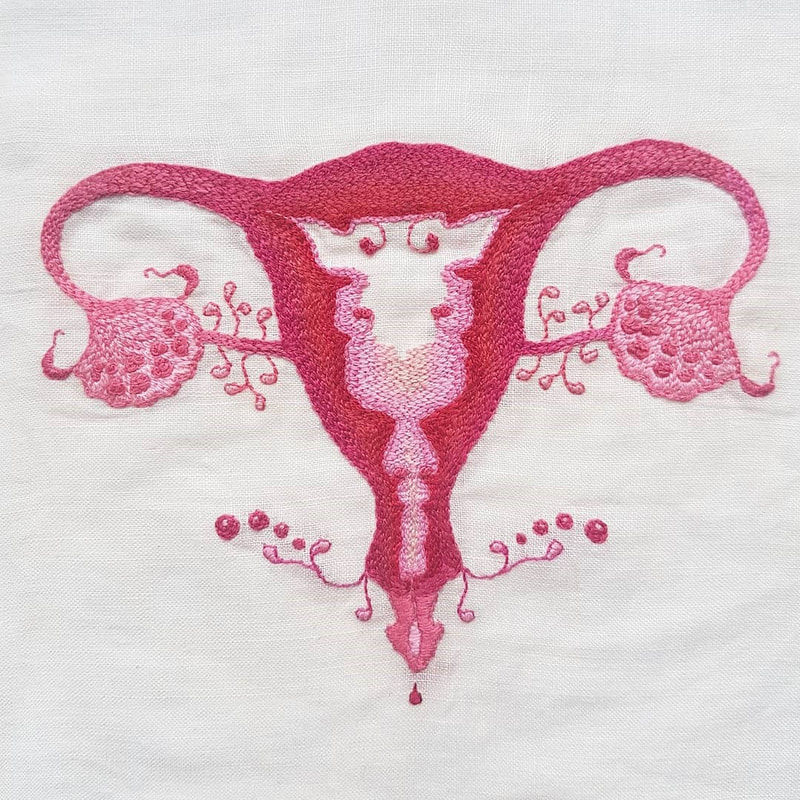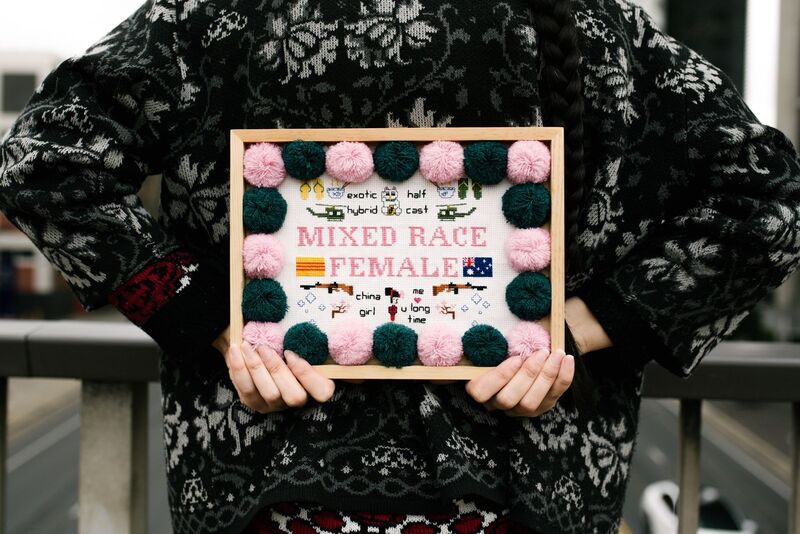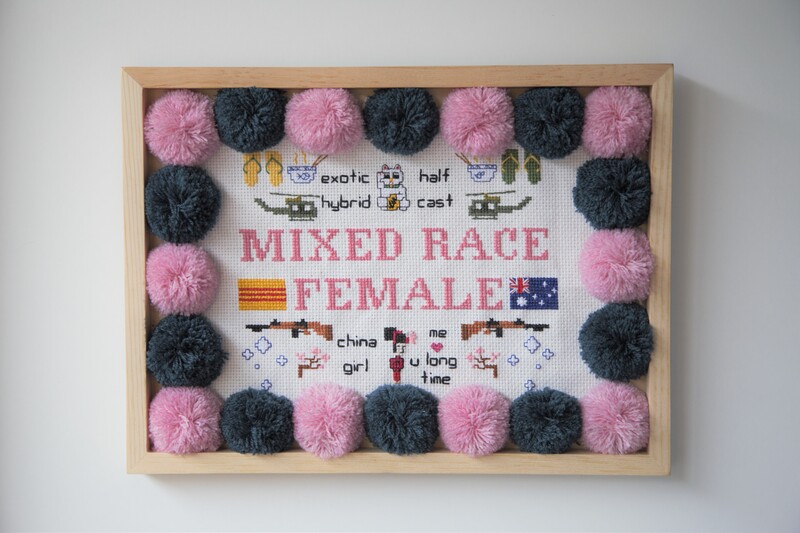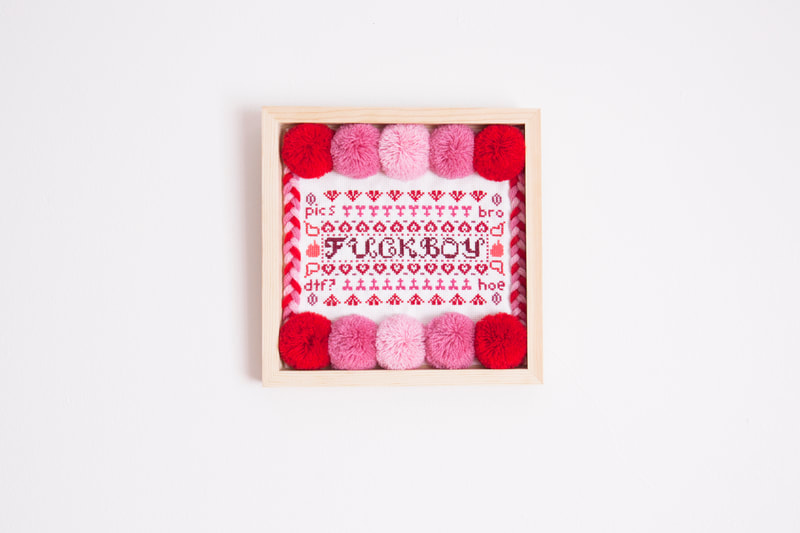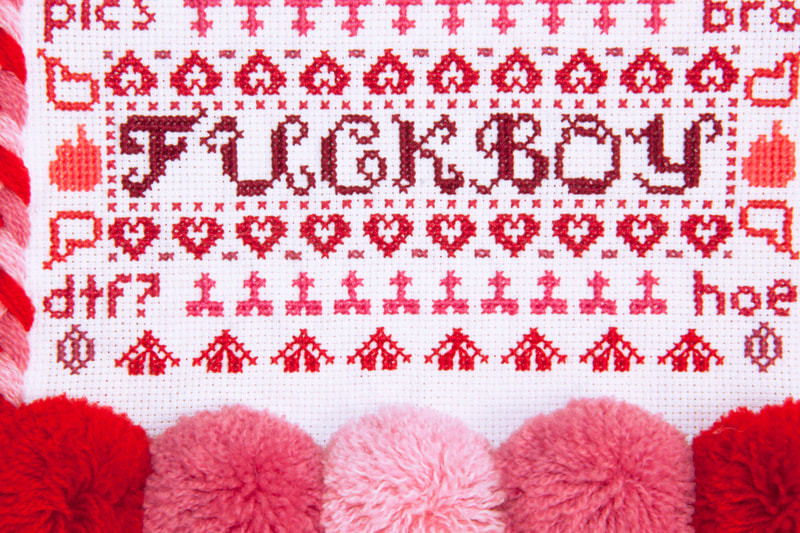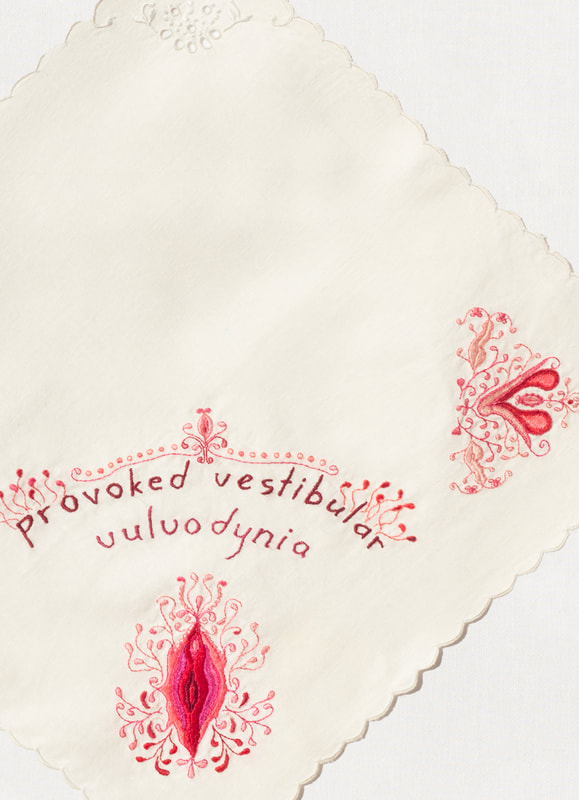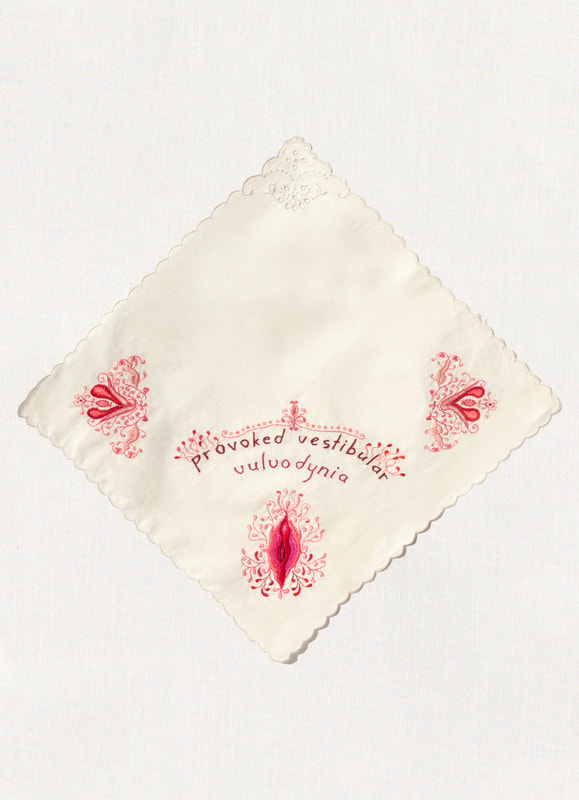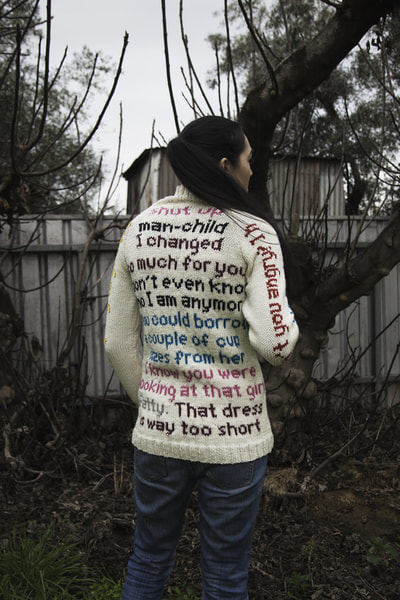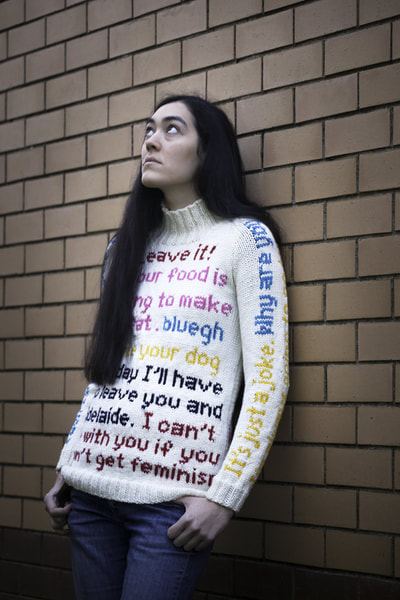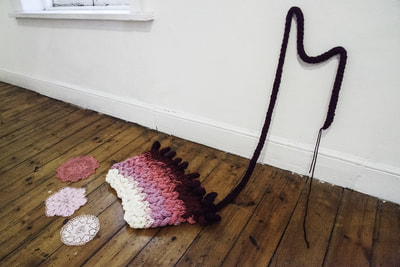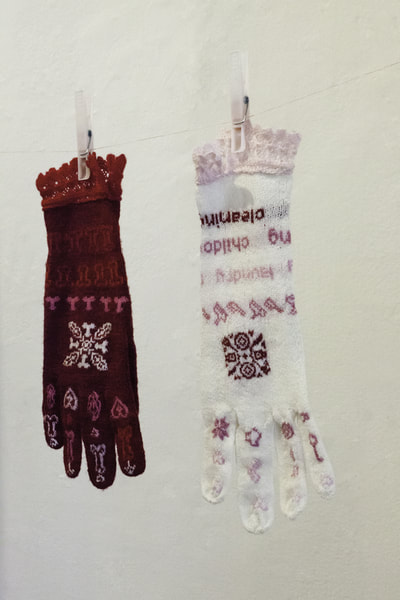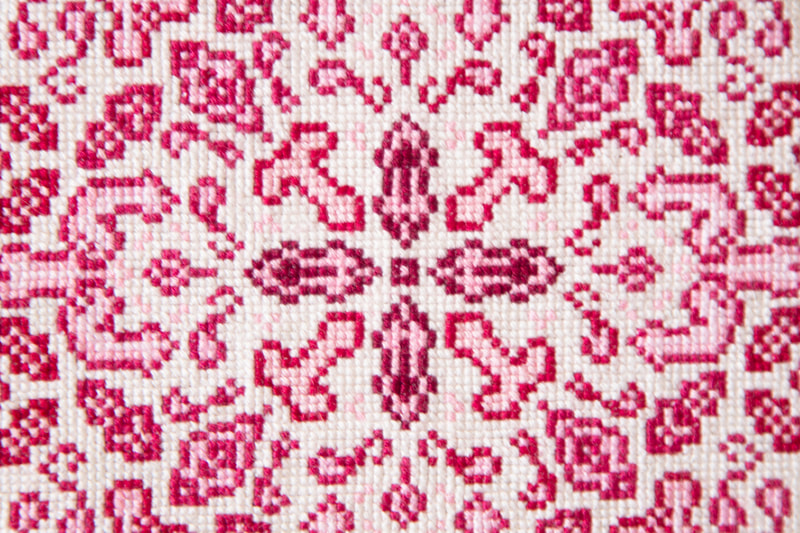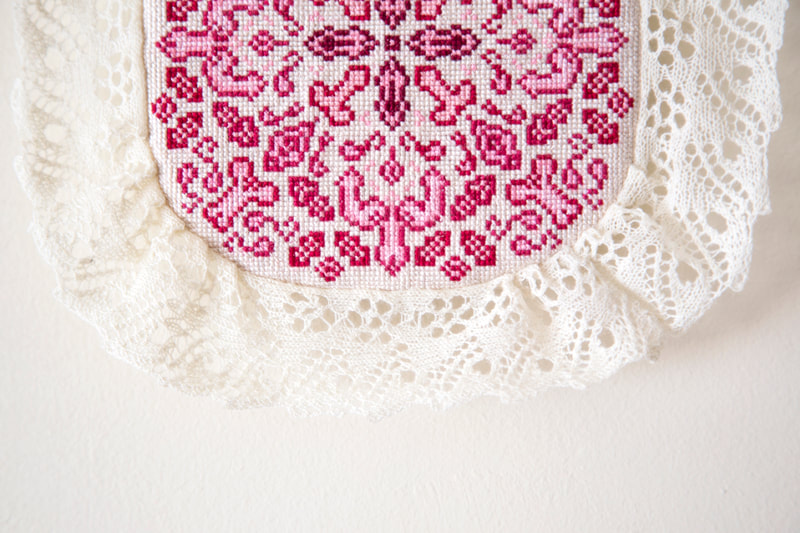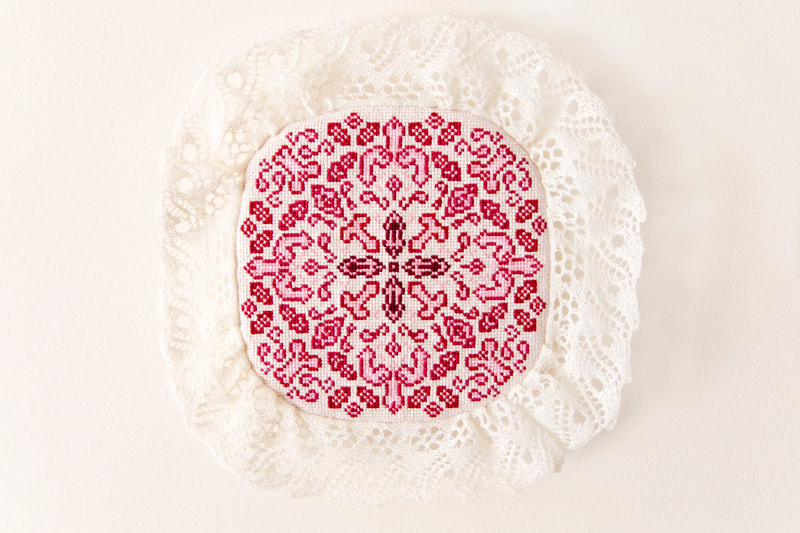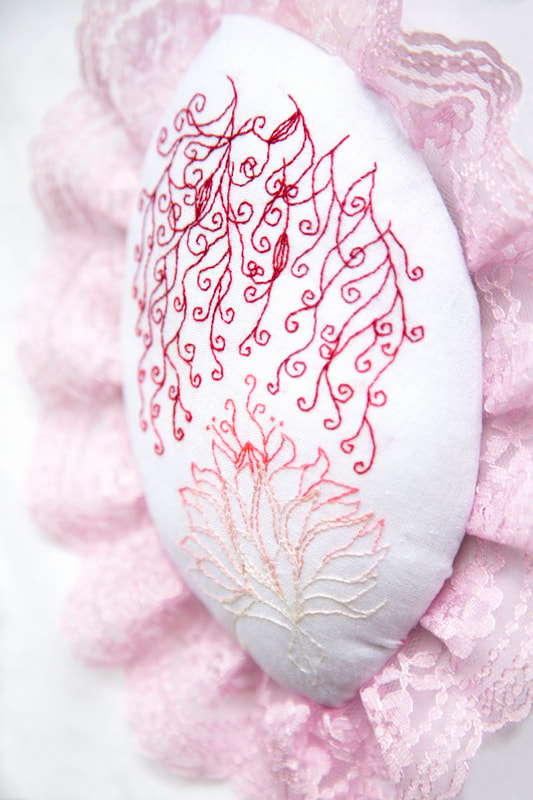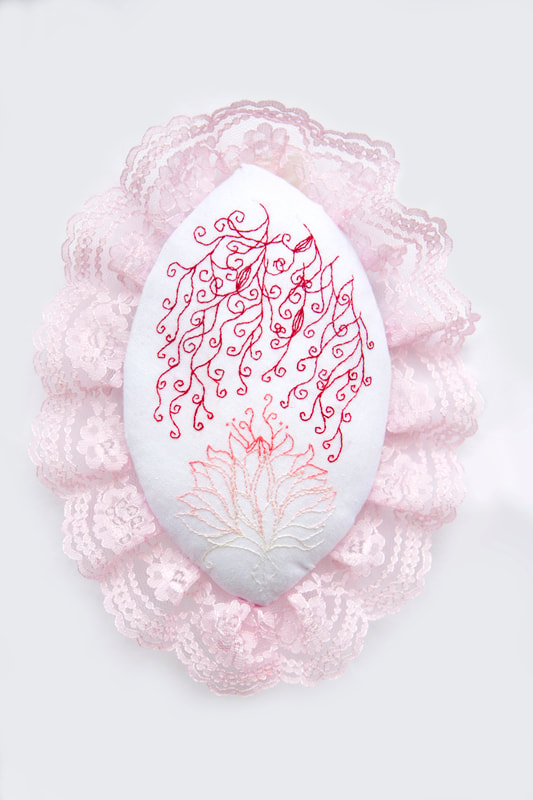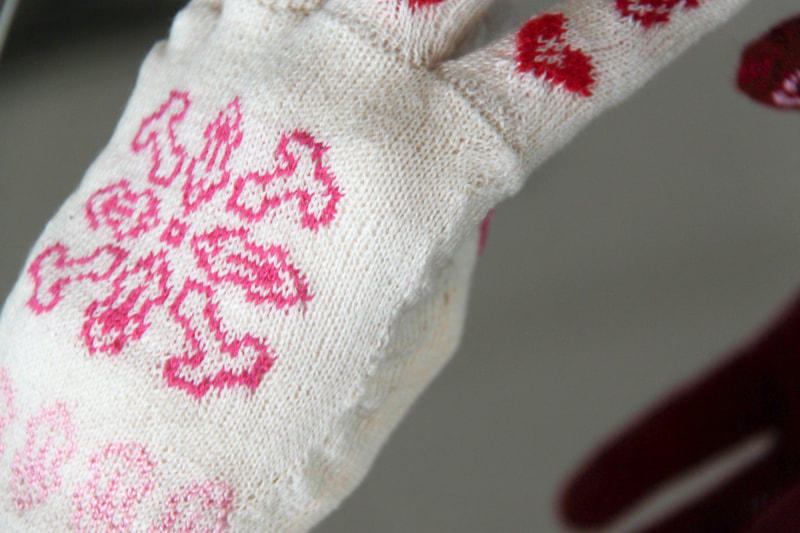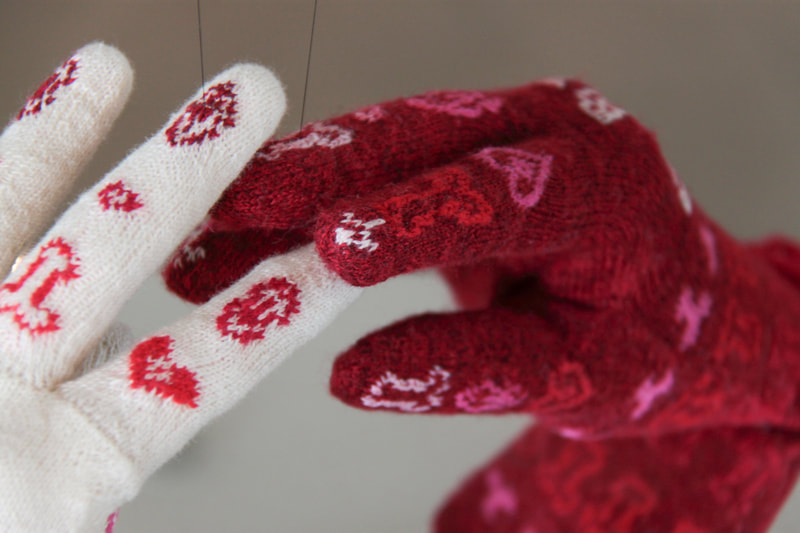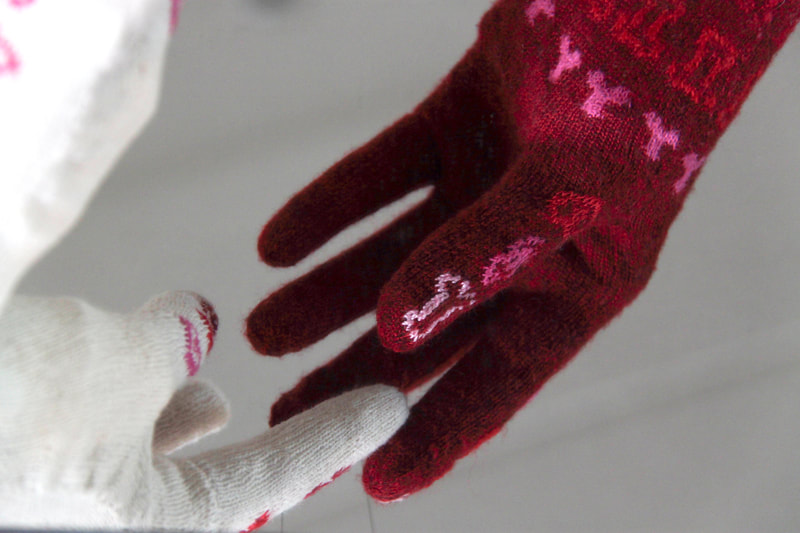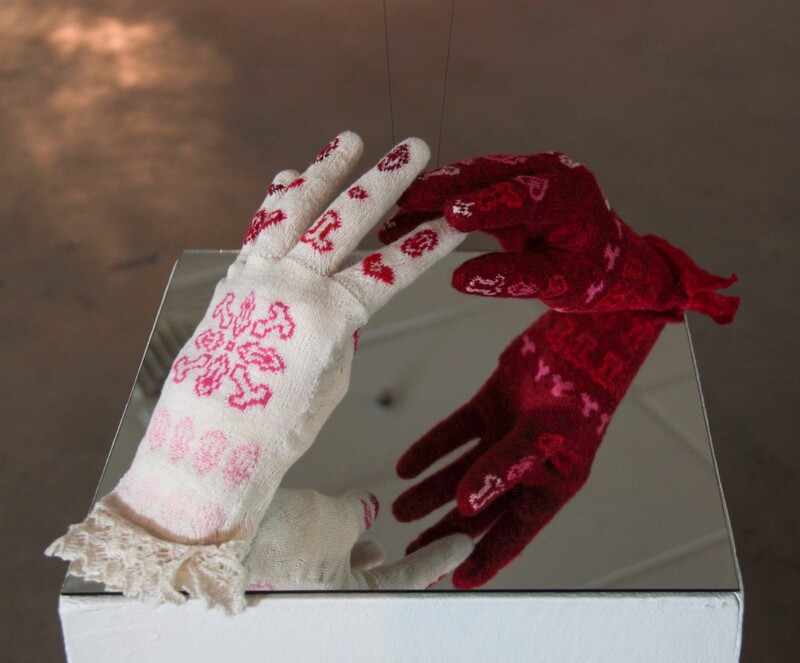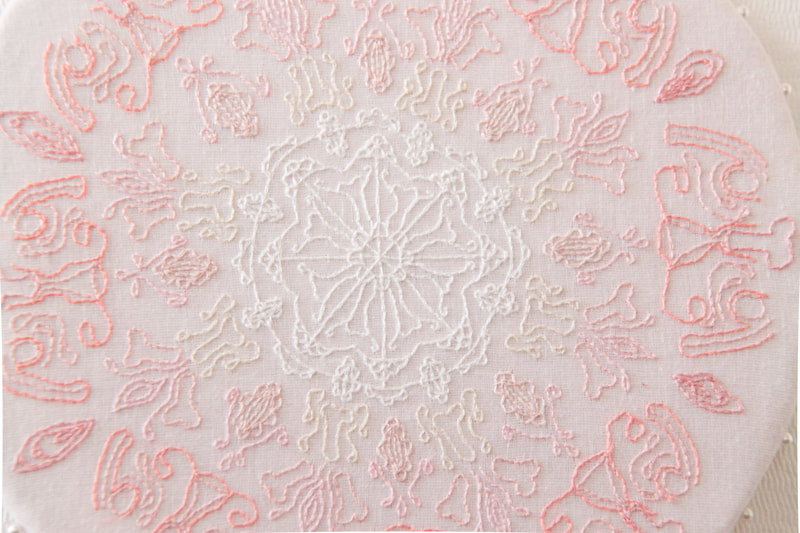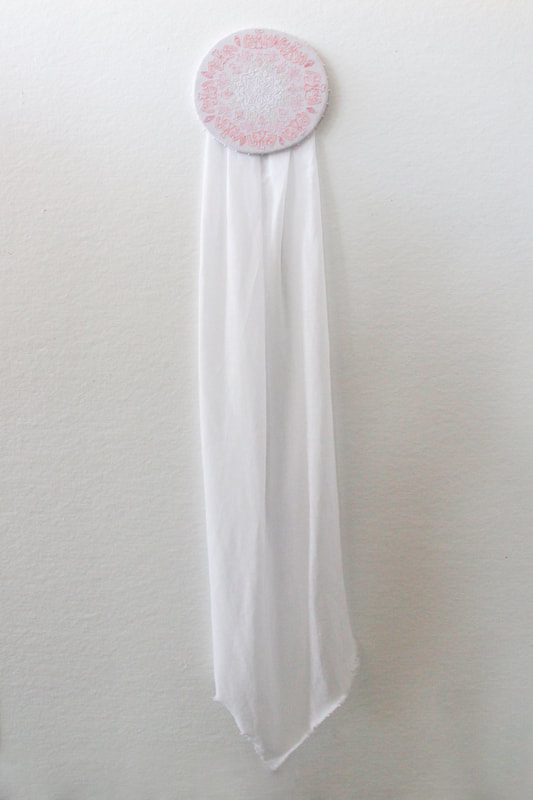Gallery
2023
Bipolar Guru, 2024, hand knitted yarn, felt, paper mache, polystyrene, sequins, nail jewels, epoxy, 120cm H x 122cm W x 11cm D, photo credit Sam Roberts
What if people with mental illnesses were venerated for their supposed 'spiritual insights' rather than stigmatised? The proliferation of unskilled and unqualified spirituality coaches online, particularly on Instagram, has spurred a counter movement. A number of legitimate spiritual practitioners are now using their platforms to debunk pseudo-spiritual dogma. I found myself consuming their content with a perverse sense of glee. Under their critical gaze, phrases such as 'divine feminine' and 'manifesting abundance' became sinister, giving clues about the ideologies of the coaches who used them. I found similarities between the claims they made and the delusions that can accompany manic episodes. Mania can induce fantasies of unlimited wealth and beliefs that the sufferer has access to divine powers. My experience of bipolar mania is that of a seductive, mystical force that must be resisted with the help of medication and stress management. The increase in energy, positive emotion and productivity that accompanies mania can make it difficult to recognise it as the symptom of an illness. In a world where self improvement intersects with commerce, what parts of ourselves are exploited? And what parts do we exploit for financial gain
What if people with mental illnesses were venerated for their supposed 'spiritual insights' rather than stigmatised? The proliferation of unskilled and unqualified spirituality coaches online, particularly on Instagram, has spurred a counter movement. A number of legitimate spiritual practitioners are now using their platforms to debunk pseudo-spiritual dogma. I found myself consuming their content with a perverse sense of glee. Under their critical gaze, phrases such as 'divine feminine' and 'manifesting abundance' became sinister, giving clues about the ideologies of the coaches who used them. I found similarities between the claims they made and the delusions that can accompany manic episodes. Mania can induce fantasies of unlimited wealth and beliefs that the sufferer has access to divine powers. My experience of bipolar mania is that of a seductive, mystical force that must be resisted with the help of medication and stress management. The increase in energy, positive emotion and productivity that accompanies mania can make it difficult to recognise it as the symptom of an illness. In a world where self improvement intersects with commerce, what parts of ourselves are exploited? And what parts do we exploit for financial gain
The Real Thing, recycled viscose nylon, machine knit by Knitup, altered mannequin fabricated by Nat Penney, dimensions variable, 2023-2024, photo credit Sam Roberts
The Real Thing (2023) is an ode to the extreme mood states that make up Makeda Duong’s experience of bipolar disorder. In a departure from her usual method of intricately hand knitting text based works, Duong elected to pursue a different process by designing a machine knit garment. Carefully chosen song lyrics, evoking the soaring highs of mania and the stagnant lows of depression, are emblazoned on the front and back. The work is titled after a song by the band Faith No More, in which Duong sees her experience of mental illness reflected.
The Real Thing (2023) is an ode to the extreme mood states that make up Makeda Duong’s experience of bipolar disorder. In a departure from her usual method of intricately hand knitting text based works, Duong elected to pursue a different process by designing a machine knit garment. Carefully chosen song lyrics, evoking the soaring highs of mania and the stagnant lows of depression, are emblazoned on the front and back. The work is titled after a song by the band Faith No More, in which Duong sees her experience of mental illness reflected.
Labour of Love, Commission, cotton embroidery on cotton, 2023
2021
|
Shit Customers Say, intarsia knitted merino wool, felt, floristry wire, W 46cm x H 207cm , 2021, photo credit Rosina Possingham, courtesy of Post Office Projects
Since 2014 I have spent several years working customer service and retail jobs in order to earn income and fund my arts practice. I have garnered a collection from my own and friends experiences, of real quotes from real customers. What began as a tongue in cheek attempt to document the occasional absurdity that comes with a customer service job, soon morphed to showcase the perceived class divisions within these interactions, and the feeling of superiority some customers have. Repeatedly I have encountered the idea that customer service jobs are not 'real' jobs, that they are always temporary, and the fallacy that there are no skills involved. During the pandemic, supermarket and service station staff were so desperately needed, and yet they are exposed to some of the worst kind of vitriol and disrespect. We can’t live without these workers, and yet they are assumed to be lazy, uneducated, and inferior. I hope this work allows people to reflect on their interactions with service workers. |
My father is from South Vietnam. Having witnessed the Vietnam War and survived living under an oppressive Communist regime, he has a very different attitude towards Communism than many young westerners, who are looking to Marxist ideals in order to critique the Capitalist system. As for myself, having been born and raised in a capitalist country, I have recently acquired a job in sales, after working for a small business for a number of years. I found myself ruminating over dollars and cents, and how to acquire more money. Here I have combined motivational sales quotes with symbols of leftist politics. I am interested in the juxtaposition between the ‘radical’ values of young people with leftist political leanings, and the experience of older immigrants who have survived oppressive regimes under Communist governments. Once again I find myself with the sensation of being caught in between two differing cultural attitudes. There is a discord between my own political ideals, and the brutal reality of my father’s memories. Is it possible to find a middle ground? How do we navigate problems within our economic system?
2020
Mixed Race Sweater
With this work I hope to touch on the complexity of being a biracial Australian by exploring issues of belonging, otherness, and the feelings of being caught in-between cultures that second and third generation immigrants can experience. The front is knitted in the colours of the Australian flag, while the back features the South Vietnamese flag colours. It showcases a collection of the questions and comments I occasionally get asked about my racial appearance. Other people’s curiosity sometimes leads me to reflect on these questions myself. What indeed am I? Am I Vietnamese? Am I Australian? Am I both? Neither? I aim to examine my own racial identity more closely, as well as explore how my identity and sense of belonging may be reflective of larger cultural anxieties within Australia.
Mixed Race Female - Solo exhibition, Nexus Arts, 2020
'With Mixed Race Female, Makeda addresses racialised otherness and mental illness – issues that will be familiar to some but are pertinent to all. In portraying these deeply personal experiences with humour and a sense somehow of detachment or removal, her work, as Lizzy Emery writes in her exhibition essay, “turns the gaze that is subjected upon the racialised other and the ‘mentally ill’ back upon the privileged, in a subversive critique of social processes of stigma and othering.” This exhibition offers an opportunity to self-examine, and to reflect on our own otherness, sameness, and privilege.' Nexus Arts, 2020
View full exhibition via link below. The Mixed Race Sweater is also featured in an online exhibition curated by Sophia Cai for Nets Victoria: Home is more than a place.
With this work I hope to touch on the complexity of being a biracial Australian by exploring issues of belonging, otherness, and the feelings of being caught in-between cultures that second and third generation immigrants can experience. The front is knitted in the colours of the Australian flag, while the back features the South Vietnamese flag colours. It showcases a collection of the questions and comments I occasionally get asked about my racial appearance. Other people’s curiosity sometimes leads me to reflect on these questions myself. What indeed am I? Am I Vietnamese? Am I Australian? Am I both? Neither? I aim to examine my own racial identity more closely, as well as explore how my identity and sense of belonging may be reflective of larger cultural anxieties within Australia.
Mixed Race Female - Solo exhibition, Nexus Arts, 2020
'With Mixed Race Female, Makeda addresses racialised otherness and mental illness – issues that will be familiar to some but are pertinent to all. In portraying these deeply personal experiences with humour and a sense somehow of detachment or removal, her work, as Lizzy Emery writes in her exhibition essay, “turns the gaze that is subjected upon the racialised other and the ‘mentally ill’ back upon the privileged, in a subversive critique of social processes of stigma and othering.” This exhibition offers an opportunity to self-examine, and to reflect on our own otherness, sameness, and privilege.' Nexus Arts, 2020
View full exhibition via link below. The Mixed Race Sweater is also featured in an online exhibition curated by Sophia Cai for Nets Victoria: Home is more than a place.
2019
Relationship Status is a contemporary reinterpretation of embroidered wedding anniversary records and marriage greetings which were crafted by German immigrants in South Australia. Wedding anniversaries were significant events that were celebrated within the community. German housewives would purchase embroidery kits to create permanent records for Green, Silver, Golden and Diamond wedding anniversaries, all representing significant milestones in a marriage. They often featured script with well-wishes towards the couple, such as ‘God’s Grace to your Green Wedding; Go joyfully towards the silver one’ and were decorated with gold leaf and metallic thread. Relationship Status explores how young people navigate contemporary relationships through an online presence. On Facebook, a person can list their ‘Relationship Status’ as ‘Single’, ‘In a Relationship’ or even ‘It’s Complicated’. These markers are often used to display whether one is available. Dating apps such as Tinder or Bumble have changed the way singles find potential partners. While our attitudes towards marriage and methods of matchmaking may have changed significantly, one’s marriage status can still be viewed within a hierarchy. Do married couples still hold a higher social status than singles?
- Makeda Duong, 2019, artist statement for Kinder, Kuche, Kurshe Exhibition at Jamfactory Seppeltsfeld
- Makeda Duong, 2019, artist statement for Kinder, Kuche, Kurshe Exhibition at Jamfactory Seppeltsfeld
2018
'‘The Vessel’ is a response to the fight for reproductive rights around the world. The idea of the womb as a vessel is not only connected to pregnancy or childbirth, but also as a space for knowledge and identity. This work is situated within the current climate of menstruation awareness.'
'My current focus is on general myths about the female reproductive system and spreading awareness about pelvic pain conditions in women, such as vulvodynia. Since I was diagnosed with this condition in 2016, I have been developing a series of works which challenge the silence and stigma associated with reproductive and sexual health. Part of my motivation to create artwork about this topic is to try and work through the psychological and physical impact it has on me, and to share my experience with others. With this body of work I aim to contextualise my personal experience as a patient and sufferer within the broader historical narrative of the ‘hysterical’ female patient.'
Makeda Duong, 2018
'My current focus is on general myths about the female reproductive system and spreading awareness about pelvic pain conditions in women, such as vulvodynia. Since I was diagnosed with this condition in 2016, I have been developing a series of works which challenge the silence and stigma associated with reproductive and sexual health. Part of my motivation to create artwork about this topic is to try and work through the psychological and physical impact it has on me, and to share my experience with others. With this body of work I aim to contextualise my personal experience as a patient and sufferer within the broader historical narrative of the ‘hysterical’ female patient.'
Makeda Duong, 2018
2017
Mixed Race Female
'This work was created for a group exhibition on diaspora and racial identity in Australia. It features pseudo Asian and Australian iconography; a geisha and a cherry blossom appear with a pair of thongs, alongside imagery from the Vietnam War. My father is from Southern Vietnam, while my mother’s side of the family is Australian. Part of the aim of this work is to explore Asian stereotypes, and how Asian and mixed race women are sometimes perceived through the lenses of exoticism and orientalism.'
Fuckboy
‘Fuckboy’ is a play on internet slang and how it intersects with contemporary sexual stereotypes. This work acts as a criticism of the hypocrisies and double standards that exist in regards to female promiscuity.
Provoked Vestibular Vulvodynia
'Over the last couple of years I have been producing work that focusses on an exploration of pelvic pain conditions. Individuals who suffer from conditions such as vulvodynia, vaginismus, endometriosis, and polycystic ovarian syndrome can sometimes suffer for years without a correct diagnosis. The mis-diagnosis and mistreatment of patients suffering from these chronic conditions reflects ongoing issues of gendered biases in the medical industry. Women are often dismissed by doctors when they articulate their symptoms, further perpetuating the widespread ignorance and stigmatisation of these conditions.
These attitudes stem from medicine historically being centred on the male body as the default ‘norm’, and the characterisation of female maladies as ‘hysteria’. Physicians would emphasise the womb as the source of all problems, and often ascribed physical symptoms in women as being psychosomatic. Today, patients with gynaecological complaints are still made to feel as if it’s ‘all in their heads’. This male dominated legacy has a lasting effect on medicine today, for example, many clinical drug trials have completely excluded female participants, to the point where governments have had to introduce legislation for the mandatory inclusion of women. This bias continues to have a lasting impact on female patients. In my work I aim to contextualise my personal experience as a patient and sufferer within the broader historical narrative of the ‘hysterical’ female patient.'
Makeda Duong, 2018
'This work was created for a group exhibition on diaspora and racial identity in Australia. It features pseudo Asian and Australian iconography; a geisha and a cherry blossom appear with a pair of thongs, alongside imagery from the Vietnam War. My father is from Southern Vietnam, while my mother’s side of the family is Australian. Part of the aim of this work is to explore Asian stereotypes, and how Asian and mixed race women are sometimes perceived through the lenses of exoticism and orientalism.'
Fuckboy
‘Fuckboy’ is a play on internet slang and how it intersects with contemporary sexual stereotypes. This work acts as a criticism of the hypocrisies and double standards that exist in regards to female promiscuity.
Provoked Vestibular Vulvodynia
'Over the last couple of years I have been producing work that focusses on an exploration of pelvic pain conditions. Individuals who suffer from conditions such as vulvodynia, vaginismus, endometriosis, and polycystic ovarian syndrome can sometimes suffer for years without a correct diagnosis. The mis-diagnosis and mistreatment of patients suffering from these chronic conditions reflects ongoing issues of gendered biases in the medical industry. Women are often dismissed by doctors when they articulate their symptoms, further perpetuating the widespread ignorance and stigmatisation of these conditions.
These attitudes stem from medicine historically being centred on the male body as the default ‘norm’, and the characterisation of female maladies as ‘hysteria’. Physicians would emphasise the womb as the source of all problems, and often ascribed physical symptoms in women as being psychosomatic. Today, patients with gynaecological complaints are still made to feel as if it’s ‘all in their heads’. This male dominated legacy has a lasting effect on medicine today, for example, many clinical drug trials have completely excluded female participants, to the point where governments have had to introduce legislation for the mandatory inclusion of women. This bias continues to have a lasting impact on female patients. In my work I aim to contextualise my personal experience as a patient and sufferer within the broader historical narrative of the ‘hysterical’ female patient.'
Makeda Duong, 2018
2015
The Cursed Boyfriend Sweater -Solo Exhibition
My practice explores how the western history of home craft textiles processes are connected to the suppression of female sexuality and contemporary gender roles. My work seeks to examine how, even with mainstream society’s adoption of feminism into pop culture, there is a lingering puritanical sexual suppression and shame surrounding female sexuality.
In the course of my practice, I have discovered that there are many parallels between the undervaluing of craft labour, and the often unpaid care work and emotional labour that women are still expected to carry out in their day to day lives.
Makeda Duong, 2015
My practice explores how the western history of home craft textiles processes are connected to the suppression of female sexuality and contemporary gender roles. My work seeks to examine how, even with mainstream society’s adoption of feminism into pop culture, there is a lingering puritanical sexual suppression and shame surrounding female sexuality.
In the course of my practice, I have discovered that there are many parallels between the undervaluing of craft labour, and the often unpaid care work and emotional labour that women are still expected to carry out in their day to day lives.
Makeda Duong, 2015
2014
2013 - University
Virginity
'Embroidery evokes the stereotype of the virgin in opposition to the whore...an infantalising representation of female sexuality.' - Rozsika Parker, The Subversive Stitch
While at university, I became preoccupied with the above quote while researching the history of embroidery in the Western world. Why is embroidery so connected to the virginal stereotype of the meek, obedient, and homebound wife, mother or daughter? My research led to the development of two separate artworks throughout my final year of University. One for the Virgin, and one to represent the Whore. Glove Love is the latter piece. The incorporation of human genitalia into the dainty, ultra feminine stitched patterns is a nod to the extreme suppression of female sexuality, historically and in contemporary society. Their visibility is a testament to the power of human sexuality and it's ongoing resistance to social constraints.
'Embroidery evokes the stereotype of the virgin in opposition to the whore...an infantalising representation of female sexuality.' - Rozsika Parker, The Subversive Stitch
While at university, I became preoccupied with the above quote while researching the history of embroidery in the Western world. Why is embroidery so connected to the virginal stereotype of the meek, obedient, and homebound wife, mother or daughter? My research led to the development of two separate artworks throughout my final year of University. One for the Virgin, and one to represent the Whore. Glove Love is the latter piece. The incorporation of human genitalia into the dainty, ultra feminine stitched patterns is a nod to the extreme suppression of female sexuality, historically and in contemporary society. Their visibility is a testament to the power of human sexuality and it's ongoing resistance to social constraints.
